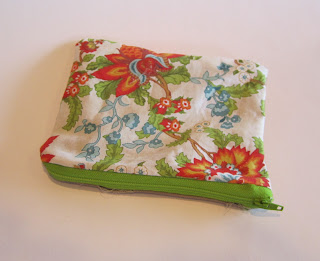After inspecting all the variations I went with the chair back tutorial on Our Scoop which was great in that it is PDF format. I print these and file them neatly in labeled manila folders, (I know! Super organized, right??), and PDFs print so much neater then straight from the web stuff. I'm always super grateful for online tutorials which are free and a ton of effort on the part of the creator. So thanks! Probably due to my complete inexperience I had a couple of problems with these directions though... I eventually figured out how to sew the bottom and sides to the front and back by ignoring the directions and thinking of them as tiny cubes like the ottoman slipcovers I made. I never could figure out how to do the rickrack properly. How in the world does it end up on the outside when you sew the two pieces right sides together...whatever, I couldn't sort it and my rickrack isn't nearly as cute since it's all on top. I'm going to work on figuring this out at some point.
 |
| Following directions, word for word. Until I get confuzzled. |
 |
| Low light is a friend to wise women and beginner's sewing projects. |
 |
| I did the second one a bit differently because I only had two buttons left, but they look cute together. The letters are all whip-stitched on by hand with pink to go with the pink rickrack. |
The biggest obstacle for me was the button holes. I've (clearly) never done it before and it took me a lot of trial and error and plenty of Googling and curse words to figure it out, but now that I know how it is done, it is not difficult at all. I intend to make button holes on everything from now on, whether buttons are called for or not.
Notes on the project:
-these aren't especially easy. The first one took me forever. Hours and hours, literally. Figuring out the buttons was a huge pit of time suckage. The second one went faster as far as sewing goes, but all the hand stitching took awhile.
-interfacing is key to keep the square shape. Some of the other tutorials have more of a pouch and less of a boxy look, but I liked the structure. It comes as at a price though: that ironing takes time too.
-the red duck cloth I used I thought would be great for durability but the straps on the back are kind of fraying at the edges, felt might have been a better choice.
-I wish I'd used a more contrasting fabric for the second one's cut out and applique work. The red with large white polka dots just don't stand out as much. The reverse (red on white) would have looked better.
-I tried to top stitch in white around the heart cut out on the first one and it didn't turn out. I ripped it out. The edge is a little too raw for my personal taste without it. I just learned about finger pressing yesterday and wish I'd known about it when working on these.
-a tip for beginners: After I finished the first one it occurred to me that the only chairs in my house these could attach to are the kids playroom chairs so make sure you have chairs with back slats somewhere before you do this project. Duh!
-cost was pretty low in terms of dollars. The fabric for the outside and the lining were both on sale, about $4/yard I think. I might do a tutorial on how to read a Joann's receipt. The Dritz button kits were $2.50-ish and I bought two, plus the thread, rickrack and interfacing (on sale, too) brought the total up to about $18 for the two chair backers. In time, these took me close to nine hours, almost all of which was spent on the first one.
Verdict: Cute! Learned how to do buttons so that was huge and "saved" about $30. Now of course I have to fill them with lovely little notes and gifts... I should have included that in the cost.






























